Cause of death AIDS Citizenship Austria Height 1.73 m | Name Rudolf Nureyev | |
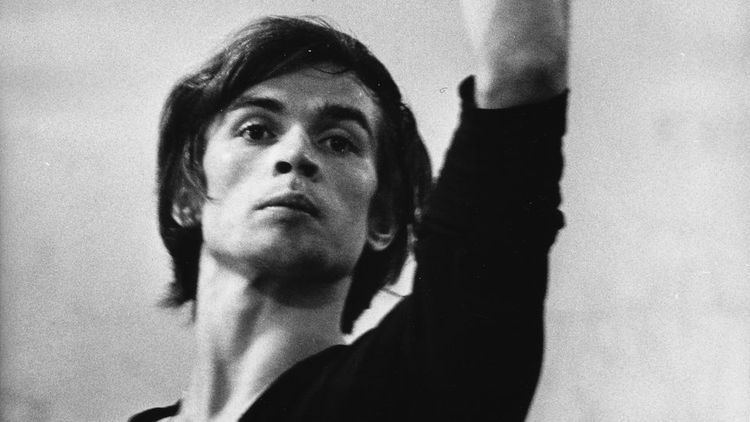 | ||
Full Name Rudolf Khametovich Nureyev Occupation Ballet dancer, choreographer Buried January 13, 1993, Sainte-Genevieve-des-Bois Russian Cemetery, Sainte-Genevieve-des-Bois, France Movies Similar People | ||
Rudolf Nureyev (1938-1993) Ballet dancer
Rudolf Khametovich Nureyev (Bashkir: Рудольф Хәмит улы Нуриев, Tatar: Рудольф Хәмит улы Нуриев, Russian: Рудо́льф Хаме́тович Нуре́ев; 17 March 1938 – 6 January 1993) was a Soviet ballet dancer and choreographer. He was director of the Paris Opera Ballet from 1983 to 1989 and its chief choreographer until October 1992.
Contents
- Rudolf Nureyev 1938 1993 Ballet dancer
- Rudolf nureyev solo debut on american tv 1963
- Early life
- Education at Vaganova Academy
- Principal with Kirov ballet
- Defection to Paris
- Royal Ballet
- Nureyev and his dance partnerships
- The Nureyev phenomenon
- Style
- Director of the Paris Opera Ballet
- Influence
- Personality and personal life
- Final years
- Death funeral and tributes
- Homage to Rudolf Nureyev
- Literature
- Reviews
- Film television and musical
- Documentary films
- References

Named Lord of the Dance, Nureyev is regarded as one of ballet's most gifted male dancers.
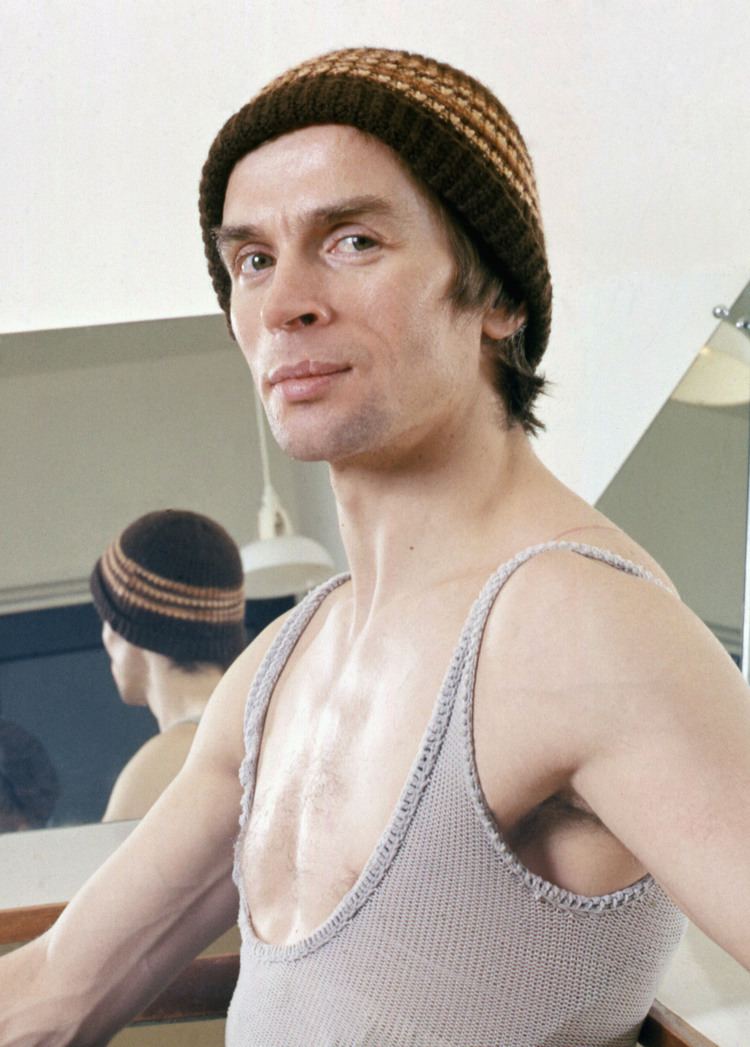
In addition to his technical prowess, Rudolf Nureyev was an accomplished choreographer. He produced his own interpretations of numerous classical works, including Swan Lake, Giselle, and La Bayadère.
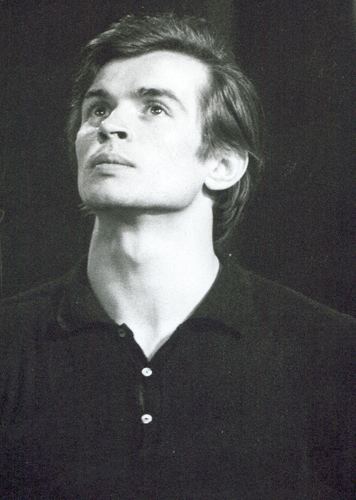
Nureyev had his early career with the Mariinsky Ballet in St. Petersburg. He defected from the Soviet Union to the West in 1961, despite KGB efforts to stop him. This was the first defection of a Soviet artist during the Cold War and it created an international sensation.
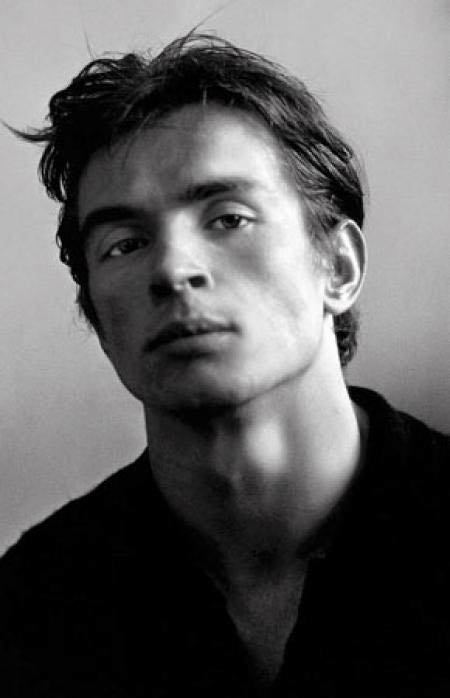
He went on to dance with The Royal Ballet in London and from 1983 to 1989 served as director of the Paris Opera Ballet.

Rudolf nureyev solo debut on american tv 1963
Early life
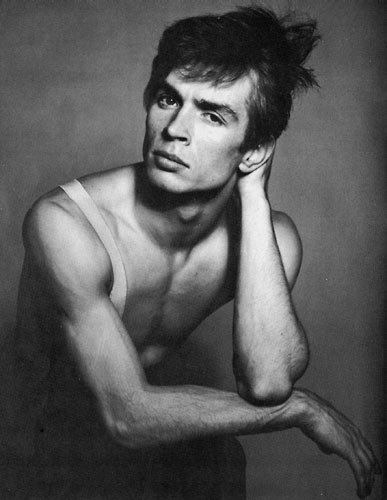
Rudolf Nureyev was born on a Trans-Siberian train near Irkutsk, Siberia, Soviet Union, while his mother, Feride, was travelling to Vladivostok, where his father Hamit, a Red Army political commissar, was stationed.
He was raised as the only son with three older sisters in a Tatar family in a village near Ufa in Bashkir ASSR, Soviet Union.
When his mother took Rudolf Nureyev and his sisters into a performance of the ballet "Song of the Cranes", he fell in love with dance. As a child he was encouraged to dance in Bashkir folk performances and his precocity was soon noticed by teachers who encouraged him to train in Saint Petersburg. On a tour stop in Moscow with a local ballet company, Nureyev auditioned for the Bolshoi ballet company and was accepted.
Education at Vaganova Academy
However, he felt that the Mariinsky Ballet school was the best, so he left the local touring company and bought a ticket to St. Petersburg.
Owing to the disruption of Soviet cultural life caused by World War II, Nureyev was unable to enroll in a major ballet school until 1955, aged 17, when he was accepted by the Vaganova Academy of Russian Ballet of Saint Petersburg, the associate school of the Mariinsky Ballet. The ballet master Alexander Ivanovich Pushkin took an interest in him professionally and allowed Nureyev to live with him and his wife.
Principal with Kirov ballet
Upon his graduation in 1958, Nureyev joined the Kirov Ballet (now Mariinsky). He moved immediately beyond the corps level, and was given solo roles as a principal dancer from the outset. Rudolf Nureyev regularly partnered Dudinskaya, the company's senior ballerina and the wife of its director, Konstantin Sergeyev. Natalia Dudinskaya, 26 years his senior, chose him as her partner in the ballet Laurencia.
Before long Rudolf Nureyev became one of the Soviet Union's best-known dancers. From 1958 to 1961, in his three years with the Mariinsky, he danced 15 rôles, usually opposite his partner, Ninel Kurgapkina, with whom he was very well paired, although she was almost a decade older than he was. Nureyev and Kurgapkina were invited to dance at a gathering at Khrushchev's dacha, and in 1959 they were allowed to travel outside the Soviet Union, dancing in Vienna at the International Youth Festival. Not long after, he was told by the Ministry of Culture that he would not be allowed to go abroad again. In one memorable incident, Nureyev interrupted a performance of Don Quixote for 40 minutes, insisting on dancing in tights and not in the customary trousers. He relented in the end, but his preferred dress code was adopted in later performances.
Defection to Paris
By the late 1950s, Rudolf Nureyev had become a sensation in the Soviet Union.
Yet, as the Mariinsky Ballet was preparing to go on a tour to Paris and London, Nureyev's rebellious character and a non-conformist attitude made him an unlikely candidate for a trip to the West, which was to be of crucial importance to the Soviet government's ambitions to portray their cultural supremacy.
Furthermore, tensions between Rudolf Nureyev and the Mariinsky's artistic director Konstantin Sergeyev, husband and former dance partner of Natalia Dudinskaya, were growing. After a representative of the French tour organizers saw Nureyev dance in Leningrad in 1960, the French organizers urged Soviet authorities to let him dance in Paris, and he was allowed to go.
In Paris, his performances electrified audiences and critics. Oliver Merlin in Le Monde wrote,
I will never forget his arrival running across the back of the stage, and his catlike way of holding himself opposite the ramp. He wore a white sash over an ultramarine costume, had large wild eyes and hollow cheeks under a turban topped with a spray of feathers, bulging thighs, immaculate tights. This was already Nijinsky in Firebird.
Nureyev was seen to have broken the rules about mingling with foreigners, which alarmed the Mariinsky's management and the KGB agents observing him. The KGB wanted to send him back to the Soviet Union. On 16 June 1961 the Mariinsky group had gathered at Le Bourget Airport in Paris to fly to London. Sergeyev then took Nureyev aside and told him that he would have to return to Moscow, for a special performance in the Kremlin. Nureyev became suspicious and refused. Next he was told that his mother had fallen severely ill and he needed to come home immediately to see her. Nureyev refused again, believing that on return to the USSR he was likely to be imprisoned. With the help of French police and a Parisian socialite friend – Clara Saint, who was engaged to the son of the French Minister of Culture Andre Malraux – Nureyev got away from his KGB minders and asked for asylum. Sergeyev and the KGB tried to discuss it with him but he chose to stay in Paris.
Within a week, he was signed up by the Grand Ballet du Marquis de Cuevas and was performing The Sleeping Beauty with Nina Vyroubova. On a tour of Denmark he met Erik Bruhn, soloist at the Royal Danish Ballet who became his lover, his closest friend and his protector until Bruhn's death in 1986.
Soviet authorities made Nureyev's father, mother and dance teacher Pushkin write letters to him, urging him to return, without effect.
Although he petitioned the Soviet government for many years to be allowed to visit his mother, he was not allowed to do so until 1987, when his mother was dying and Mikhail Gorbachev consented to the visit. In 1989, he was invited to dance the role of James in La Sylphide with the Mariinsky Ballet at the Mariinsky Theatre in St. Petersburg. The visit gave him the opportunity to see many of the teachers and colleagues he had not seen since his defection.
Royal Ballet
Nureyev's first appearance in the United Kingdom was at a ballet matinée organised by The Royal Ballet's Prima Ballerina Dame Margot Fonteyn in 1961. The event was held in aid of the Royal Academy of Dance, a classical ballet teaching organisation of which she was President. He danced Poème Tragique, a solo choreographed by Frederick Ashton, and the Black Swan pas de deux from Swan Lake.
Dame Ninette de Valois offered him a contract to join The Royal Ballet as Principal Dancer. His first appearance with the company was partnering Margot Fonteyn in Giselle on 21 February 1962. Fonteyn and Nureyev would go on to form a partnership. Nureyev stayed with the Royal Ballet until 1970, when he was promoted to Principal Guest Artist, enabling him to concentrate on his increasing schedule of international guest appearances and tours. He continued to perform regularly with The Royal Ballet until committing his future to the Paris Opera Ballet in the 1980s.
Nureyev and his dance partnerships
Yvette Chauviré of the Paris Opera Ballet often danced with Nureyev; he described her as a "legend". Chauviré attended his funeral with French dancer and actress Leslie Caron.
Rudolf Nureyev and Margot Fonteyn at the Royal Ballet became long-standing dance partners. Nureyev once said of Fonteyn, who was 19 years older than him, that they danced with "one body, one soul". Together Nureyev and Fonteyn premiered Sir Frederick Ashton's ballet Marguerite and Armand, a ballet danced to Liszt's Piano Sonata in B minor, which became their signature piece. Kenneth MacMillan was forced to allow them to premiere his Romeo and Juliet, which was intended for two other dancers, Lynn Seymour and Christopher Gable. Films exist of their partnership in Les Sylphides, Swan Lake, Romeo and Juliet, and other roles. They continued to dance together for many years after Nureyev's departure from the Royal Ballet. Their last performance together was in Baroque Pas de Trois on 16 September 1988 when Fonteyn was 69, Nureyev was aged 50, with Carla Fracci also starring, aged 52.
He celebrated another long-time partnership with Eva Evdokimova. They first appeared together in La Sylphide (1971) and in 1975 he selected her as his Sleeping Beauty in his staging for London Festival Ballet. Evdokimova remained his partner of choice for many guest appearances and tours across the globe with "Nureyev and Friends" for more than fifteen years.
The Nureyev phenomenon
Advocates to describe the Nureyev phenomenon precisely are John Tooley, former general director of the Royal Opera House, London, Pierre Bergé, former president of Opéra Bastille, venue of the Paris Opera Ballet (in addition to the Palais Garnier) and Manuel Legris, principal dancer with the Paris Opera Ballet nominated by Rudolf Nureyev in New York.
Tooley wrote that Nureyev grew up very poor and had to make up for three to five years in ballet education at a high-level ballet school, giving him a decisive impetus to acquire the maximum of technical skills and to become the best dancer working on perfection during his whole career. The challenge for all dancers whom Nureyev worked with was to follow suit and to share his total commitment for dance.
Nureyev entered the Vaganova Ballet Academy at the age of just 17 staying there for only 3 years whereas dancers who will become principal dancers later on often enter the Vaganova school at 9 and go through the full 9 years of dance education.
Vladimir Vasiliev, peer of Nureyev at the Bolshoi and regarded with Rudolf Nureyev and Mikhail Baryshnikov as one of the top three ballet dancers, became a pupil of the Vaganova Ballet Academy in 1949, graduating in 1958 together with Nureyev. Baryshnikov passed only three years at the Vaganova school of St. Peterburg like Nureyev.
Now, paradoxically, both Rudolf Nureyev and Mikhail Baryshnikov became master of perfection in dance. Dance and life was one and the same.
Nureyev put it like this: "I approach dancing from a different angle than those who begin dancing at 8 or 9. Those who have studied from the beginning never question anything."
Pierre Bergé said about Rudolf Nureyev: "He was a dancer like any other dancer. It is extraordinary to have 19 points out of 20. It is extremely rare to have 20 out of 20. However, to have 21 out of 20 is even much rarer. And this was the situation with Nureyev."
Legris said: "Rudolf Nureyev was a high-speed train (he was a TGV)." Working with Rudolf Nureyev involved having to surpass oneself and stepping on it.
Style
Mikhail Baryshnikov, the other great dancer who like Nureyev defected to the West, holds Nureyev in high regard.
Baryshnikov told in an interview that Rudolf Nureyev was an unusual man in all respects, instinctive, intelligence, constant curiosity, and extraordinary discipline, that was his goal of life and of course love in performing.
Director of the Paris Opera Ballet
In 1982, Nureyev became a naturalized citizen of Austria. In 1983, he was appointed director of the Paris Opera Ballet, where, as well as directing, he continued to dance and to promote younger dancers. He remained there as a dancer and chief choreographer until 1989. Among the dancers he groomed were Sylvie Guillem, Isabelle Guérin, Manuel Legris, Elisabeth Maurin, Élisabeth Platel, Charles Jude, and Monique Loudières.
His artistic directorship of the Paris Opera Ballet was a great success, lifting the company out of a dark period. His Sleeping Beauty remains in the repertoire and was revived and filmed with his protégé Manuel Legris in the lead.
Despite advancing illness towards the end of his tenure, he worked tirelessly, staging new versions of old standbys and commissioning some of the most ground-breaking choreographic works of his time. His own Romeo and Juliet was a popular success. When he was sick towards the end of his life, he worked on a final production of La Bayadère which closely follows the Mariinsky Ballet version he danced as a young man.
Influence
Nureyev was above all a stickler for classical technique, and his mastery of it made him a model for an entire generation of dancers. If the standard of male dancing rose so visibly in the West after the 1960s, it was largely because of Mr. Nureyev's inspiration.
Nureyev's influence on the world of ballet changed the perception of male dancers; in his own productions of the classics the male roles received much more choreography. Another important influence was his crossing the borders between classical ballet and modern dance by performing both. Today it is normal for dancers to receive training in both styles, but Nureyev was the originator and excelled in modern and classical dance. He went out of his way to work with modern dance great, Martha Graham, and she created a work specially for him. While Gene Kelly had done much to combine modern and classical styles in film, he came from a more Modern Dance influenced "popular dance" environment, while Nureyev made great strides in gaining acceptance of Modern Dance in the "Classical Ballet" sphere.
Rudolf Nureyev's charisma, commitment and generosity were such that he did not just pass on his knowledge. He personified the school of life for a dancer.
Several dancers, who were principals with the Paris Opera Ballet under his direction, went on to become ballet directors themselves inspired to continue Nureyev's work and ideas. Manuel Legris is director of the Vienna State Ballet, Laurent Hilaire is ballet director of the Stanislavski Theatre of Moscow and Charles Jude ballet director of the Grand Théâtre de Bordeaux.
Personality and personal life
Rudolf Nureyev did not have much patience with rules, limitations and hierarchical order and had at times a volatile temper. He was apt to throw tantrums in public when frustrated. His impatience mainly showed itself when the failings of others interfered with his work.
He socialized with Gore Vidal, Freddie Mercury, Jackie Kennedy Onassis, Mick Jagger, Liza Minnelli, Andy Warhol, Lee Radziwill and Talitha Pol, and occasionally visited the legendary New York discotheque Studio 54 in the late 1970s, but developed an intolerance for celebrities. He kept up old friendships in and out of the ballet world for decades, and was considered to be a loyal and generous friend.
Most ballerinas with whom Rudolf Nureyev danced, including Antoinette Sibley, Gelsey Kirkland and Annette Page paid tribute to him as a considerate partner. He was known as extremely generous to many ballerinas, who credit him with helping them during difficult times. In particular, the Canadian ballerina Lynn Seymour – distressed when she was denied the opportunity to premiere MacMillan's Romeo and Juliet – says that Nureyev often found projects for her even when she was suffering from weight issues and depression and thus had trouble finding roles.
Depending on the source, Nureyev is described as either bisexual, as he did have heterosexual relationships as a younger man, or gay. He had a turbulent sex life, with numerous bathhouse visits and anonymous pickups. Nureyev met Erik Bruhn, the celebrated Danish dancer, after Nureyev defected to the West in 1961. Nureyev was a great admirer of Bruhn, having seen filmed performances of the Dane on tour in the Soviet Union with the American Ballet Theatre, although stylistically the two dancers were very different. Bruhn and Nureyev became a couple and the two remained together off and on, with a very volatile relationship for 25 years, until Bruhn's death in 1986.
In 1973 Nureyev met the 23-year-old American dancer Robert Tracy and a two-and-a-half-year love affair began. Tracy later became Nureyev's secretary and live-in companion. According to Tracy, Nureyev said that he had had sex with three women in his life, he had always wanted a son, and once had plans to father one with Nastassja Kinski.
Final years
When AIDS appeared in France's news around 1982, Nureyev took little notice. The dancer tested positive for HIV in 1984, but for several years he simply denied that anything was wrong with his health. However, by the late 1980s his diminished capabilities disappointed his admirers who had fond memories of his outstanding prowess and skill. Nureyev began a marked decline only in the summer of 1991 and entered the final phase of the disease in the spring of 1992.
In March 1992, living with advanced AIDS, he visited Kazan and appeared as a conductor in front of the audience at Musa Cälil Tatar Academic Opera and Ballet Theater, which now presents the Rudolf Nureyev Festival in Tatarstan. Returning to Paris, with a high fever, he was admitted to the hospital Notre Dame du Perpétuel Secours in Levallois-Perret, a suburb northwest of Paris, and was operated on for pericarditis, an inflammation of the membranous sac around the heart. At that time, what inspired him to fight his illness was the hope that he could fulfill an invitation to conduct Prokofiev's Romeo and Juliet at an American Ballet Theatre benefit on 6 May 1992 at the Metropolitan Opera House in New York. He did so and was elated at the reception.
In July 1992, Nureyev showed renewed signs of pericarditis but determined to forswear further treatment. His last public appearance was on 8 October 1992, at the premiere at Palais Garnier of a new production of La Bayadère that he choreographed after Marius Petipa for the Paris Opera Ballet. Nureyev had managed to obtain a photocopy of the original score by Minkus when in Russia in 1989. The ballet was a personal triumph although the gravity of his condition was evident. The French Culture Minister, Jack Lang, presented him that evening on stage with France's highest cultural award, the Commandeur de l'Ordre des Arts et des Lettres.
Death, funeral and tributes
Nureyev re-entered the hospital Notre Dame du Perpétuel Secours in Levallois-Perret on 20 November 1992 and remained there until his death from cardiac complications at age 54 on 6 January 1993. His funeral was held in the marble foyer of the Paris Garnier Opera House. Many paid tributes to his brilliance as a dancer. One such tribute came from Oleg Vinogradov of the Mariinsky Ballet in Saint Petersburg, Russia, stating: "What Nureyev did in the west, he could never have done here."
Nureyev's grave, at a Russian cemetery in Sainte-Geneviève-des-Bois near Paris, features a tomb draped in a mosaic of an oriental carpet. Nureyev was an avid collector of beautiful carpets and antique textiles. As his coffin was lowered into the ground, music from the last act of Giselle was played and his ballet shoes were cast into the grave along with white lilies.
After so many years of having been denied a place in the Mariinsky Ballet history, Nureyev's reputation was restored. His name was reentered in the history of the Mariinsky and some of his personal effects were placed on display at the theatre museum in St. Petersburg. At the famed Vaganova Academy a rehearsal room was named in his honour.
As of October 2013, the Centre National du Costume de Scene has a permanent collection of Nureyev's costumes "that offers visitors a sense of his exuberant, vagabond personality and passion for all that was rare and beautiful."
In 2015 he was inducted into the Legacy Walk.
Homage to Rudolf Nureyev
At the Paris Opera there is a tradition to organize a dance night as homage to Rudolf Nureyev every ten years after he died in 1993. The homage to Nureyev was scheduled on 20 March 2003 and on 6 March 2013 respectively because he was born in March. Peers of Rudolf Nureyev speaking about him and remembering him like Mikhail Baryshnikov are often deeply touched.
Literature
The novelist Colum McCann wrote a novel about Nureyev's life titled Dancer published in 2003.
Reviews
Film, television and musical
In 1962, Nureyev made his screen debut in a film version of Les Sylphides. He decided against an acting career in order to branch into modern dance with the Dutch National Ballet in 1968.
In 1972, Sir Robert Helpmann invited him to tour Australia with Nureyev's production of Don Quixote. The film version (1973) was directed by Nureyev and Helpman and features Nureyev as Basilio, Lucette Aldous as Kitri, Helpmann as Don Quixote and artists of the Australian Ballet.
In 1977 he played Rudolph Valentino in Ken Russell's film Valentino.
In 1978 he appeared as a guest star on the television series The Muppet Show where he danced in a parody called "Swine Lake", sang "Baby, It's Cold Outside" in a sauna duet with Miss Piggy, and sang and tap-danced in the show's finale, "Top Hat, White Tie and Tails". His appearance is credited with making Jim Henson's series become one of the sought after programs to appear in.
In 1983 he had a non-dancing role in the movie Exposed with Nastassja Kinski.
In 1989, he toured the United States and Canada for 24 weeks with a revival of the Broadway musical The King and I.
